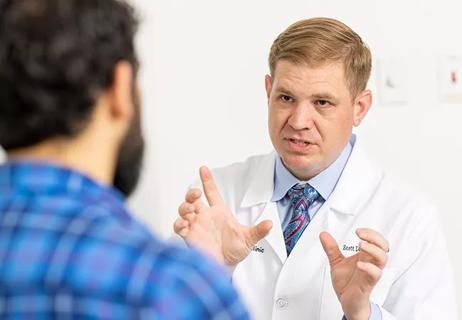Findings expand upon earlier data, providing new noninvasive options

Cleveland Clinic urology researchers have made a startling discovery that holds major potential for noninvasive treatment of idiopathic male infertility: The aromatase inhibitor anastrozole improves sperm count even in men who don’t have elevated estrogen levels.
Advertisement
Cleveland Clinic is a non-profit academic medical center. Advertising on our site helps support our mission. We do not endorse non-Cleveland Clinic products or services. Policy
The drug, which blocks the body from converting testosterone to estrogen, is approved for treating women with postmenopausal breast cancer. It has also long been used off-label to empirically treat infertility in men with elevated estrogen levels, i.e. a testosterone-estradiol ratio of less than 10 as well as men with morbid obesity who have high aromatase levels.
Now, however, teams from Cleveland Clinic and the University of California, Los Angeles, have discovered that anastrozole’s ability to increase sperm count may extend beyond those with elevated estrogen levels or body mass index. Rather, the men most likely to respond are those with a testosterone-luteinizing hormone ratio of 100 or greater.
That discovery considerably broadens the population who might benefit from the drug, according to lead author Scott D. Lundy, MD, PhD, of Cleveland Clinic’s Department of Urology.
“We found that the estrogen may not tell the whole story. What matters most is how efficiently the testicle is making testosterone. This contradicts every paper published on this topic to date that I’m aware of. It suggests that we can offer anastrozole to many more men than we have been, because very few men have high estrogen while other men with low estrogen will still respond to this medication well,” he says.
If replicated with further study, the finding potentially expands noninvasive fertility treatment options and may minimize the need for expensive reproductive technology, Dr. Lundy points out.
In the retrospective cohort study of 90 men with infertility treated with anastrozole (average dose 3mg/week) at one of the two tertiary academic medical centers, 41 (46%) experienced a clinically significant improvement in semen quality, while 12% experienced downgrades.
Advertisement
Those who responded to anastrozole had lower pretreatment levels of luteinizing hormone (4.7 vs. 8.3 IU/L) and follicle stimulating hormone (4.7 vs. 6.7 IU/mL), and higher levels of testosterone (356 vs. 265 ng/dL), but there was no difference in baseline estradiol (73% vs. 72% had levels of 25pg/mL or greater).
The responders also had higher baseline semen concentration (3.6 vs. 0.3 M/mL) and higher total motile sperm counts (3.7 vs. 0.1 M/mL). Anastrozole converted 26 of the men (29%) to normozoospermia and enabled intrauterine insemination in 20 (31%) who had previously been ineligible.
Neither body mass index nor baseline estradiol or estradiol-testosterone ratio were associated with improvements.
In multivariate analysis, both the testosterone-luteinizing hormone ratio and baseline non-azoospermia were significant predictors of improvement, with odds ratios 1.02 and 9.4, respectively. A testosterone-luteinizing hormone ratio ≥ 100 was 98% sensitive and 33% specific for WHO-SCC upgrades.
On the other hand, 16 of 17 with azoospermia did not respond to anastrozole. Thus, another clinical takeaway from this study is that “men with azoospermia rarely respond to anastrozole and should be counseled on alternative treatments,” Dr. Lundy notes.
The findings were published in Fertility and Sterility.
Previously, Dr. Lundy and the Cleveland Clinic urology team examined predictors of WHO-SCC response of infertile men to clomiphene citrate, which stimulates the pituitary gland to secrete follicle-stimulating hormone and luteinizing hormone. It is approved to treat infertility in women and its use in men is also off-label.
Advertisement
In that study, published in 2022 in Andrologia, clomiphene citrate worked in about a third of infertile men, particularly those with lower pre-treatment follicle-stimulating hormone levels. Those with FSH above 15 IU/ml were unlikely to benefit.
Taken together, the data from both studies point to the potential for more individualized treatment approaches for men with infertility. The Cleveland Clinic team’s next steps will be to investigate the combination of anastrozole and clomiphene citrate to see if the two drugs work even better together.
And, Dr. Lundy says, “In the near future we want to use artificial intelligence in a large pool of patients to develop a data-driven treatment algorithm” for men with idiopathic infertility.
In the meantime, clinicians can consider offering anastrozole to men with testosterone-luteinizing hormone ratios of 100 or greater before resorting to more expensive alternatives. After all, the drug costs just a few dollars a month, compared to roughly $20,000 per in-vitro fertilization cycle. “Part of our goal is to help couples conceive without having to foot that bill,” he notes.
Of course, patients must be counseled on the potential side effects of anastrozole, including reduced bone mineral density, headaches, nausea, diarrhea and mood changes.
According to Dr. Lundy, “The traditional dogma that high estrogen is a trigger for this medication still holds true, but we think that other patients will also benefit. The data say that if we use that approach, we have a very high likelihood of succeeding.”
Advertisement
Advertisement

Reproductive urologists publish a contemporary review to guide practice

How a multicenter consortium aims to change the research landscape

Sperm counts haven’t declined among American men in recent years, new research from Cleveland Clinic finds.

Male factors play a role in about half of all infertility cases, yet men often are not evaluated

Meta-analysis assesses outcomes in adolescent age vs. mid-adulthood

Early, individualized diagnosis and comprehensive management key to preserving fertility

Mental health colleagues can provide much-needed perspective

Pediatric urologists lead quality improvement initiative, author systemwide guideline